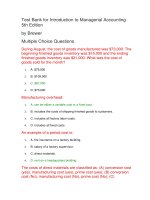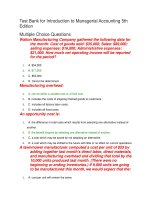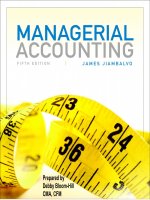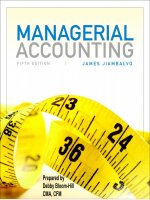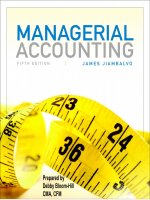Managerial accounting 5th jiambalvo ch02
Bạn đang xem bản rút gọn của tài liệu. Xem và tải ngay bản đầy đủ của tài liệu tại đây (2.79 MB, 55 trang )
Prepared by Debby Bloom-Hill
CMA, CFM
CHAPTER
CHAPTER 22
Job-Order Costing for Manufacturing
&
Service Companies
Manufacturing
Manufacturing Costs
Costs
Direct Materials
Cost of labor directly traceable to items produced
Labor costs not directly traceable are indirect labor
Manufacturing Overhead
Slide 2-3
Materials not directly traceable are indirect materials
Direct Labor
Cost of materials directly traceable to items produced
Cost of manufacturing activities other than direct materials and direct labor
Learning objective 1: Distinguish between manufacturing and nonmanufacturing costs and between product and
period costs
Merchandising
Merchandising and
and Manufacturing
Manufacturing Firms
Firms
Slide 2-4
Learning objective 1: Distinguish between manufacturing and nonmanufacturing costs and between product
and period costs
Common
Common Manufacturing
Manufacturing Overhead
Overhead Costs
Costs (Illustration
(Illustration 2-2)
2-2)
Slide 2-5
Learning objective 1: Distinguish between manufacturing and nonmanufacturing costs and between
product and period costs
Nonmanufacturing
Nonmanufacturing Costs
Costs
Nonmanufacturing costs (also known as period costs) are all costs that
are not associated with the production of goods
Selling Costs
Costs associated with securing and filling customer orders e.g. advertising,
sales salaries, depreciation of sales equipment
General and Administrative Costs
Costs associated with the firm’s general management e.g. Human
resources, accounting, corporate headquarters and other support costs
Slide 2-6
Learning objective 1: Distinguish between manufacturing and nonmanufacturing costs and between product
and period costs
Product
Product and
and Period
Period Costs
Costs
Product Costs
Costs assigned to goods produced (i.e. direct materials, direct labor,
and manufacturing overhead)
Included in inventory until goods sold
Period Costs
Costs identified with accounting periods (i.e selling and
administrative expenses)
Slide 2-7
Expensed in period incurred
Learning objective 1: Distinguish between manufacturing and nonmanufacturing costs and between product
and period costs
Relationships
Relationships Among
Among Cost
Cost Categories
Categories
Slide 2-8
Learning objective 1: Distinguish between manufacturing and nonmanufacturing costs and between
product and period costs
Test Your Knowledge 1
Which of the following is not a product cost?
a. Depreciation on manufacturing equipment
b. Indirect materials
c. Insurance on manufacturing equipment
d. Bonuses compensation to the company president
Answer:
d. Bonuses compensation to the company president (administrative
expense)
Slide 2-9
Learning objective 1: Distinguish between manufacturing and nonmanufacturing costs and between
product and period costs
Test Your Knowledge 2
Which of the following is a period cost?
a. Raw materials costs
b.Manufacturing plant maintenance
c. Depreciation on plant equipment
d.Depreciation on salespersons’ laptops
Answer:
d. Depreciation on salespersons’ laptops (selling expense)
Slide 2-10
Learning objective 1: Distinguish between manufacturing and nonmanufacturing costs and between
product and period costs
Test Your Knowledge 3
Which of the following is a direct materials cost?
a. Steel for a ship builder
b. Postage and supplies in the mailroom
c. Factory rent
d. Wages for production line workers
Answer:
a. Steel for a ship builder
Slide 2-11
Learning objective 1: Distinguish between manufacturing and nonmanufacturing costs and between product and period costs
Product
Product Cost
Cost in
in Financial
Financial Reporting/Decision
Reporting/Decision Making
Making
Manufacturing companies use product costs to prepare financial
statements and for managerial decisions
Often the cost information needed is different for the two purposes
Decision making relies on incremental analysis – an analysis of the
revenues and expenses that will actually increase or decrease as a
result of the decision
You will need to separate the variable and fixed costs to do an
incremental analysis
Slide 2-12
Learning objective 1: Distinguish between manufacturing and nonmanufacturing costs and between product and period costs
Decision
Decision Making/
Making/
Incremental
Incremental Analysis
Analysis
Incremental analysis
Direct materials and direct labor are incremental
Only 10% of overhead ($248) is incremental
Incremental revenue exceeds incremental cost by $752. Thus, Bob should place the
ad.
Slide 2-13
Learning objective 1: Distinguish between manufacturing and nonmanufacturing costs and between product and period costs
Balance
Balance Sheet
Sheet Presentation
Presentation of
of Product
Product Costs
Costs
Raw materials inventory
hand
Work in process inventory
Includes cost of materials on
Includes goods partially
complete
Finished goods inventory
Includes cost of items ready for
sale
Slide 2-14
Learning objective 2: Balance sheet presentation of product costs
Flow
Flow of
of Product
Product Costs
Costs
Slide 2-15
Learning objective 3: Describe the flow of product costs in a manufacturing firm’s accounts
Flow
Flow of
of Product
Product Costs
Costs in
in Accounts
Accounts
1.
2.
3.
4.
5.
6.
7.
Purchased materials
Requisitioned direct and indirect materials
Incurred and paid for direct and indirect labor
Incurred and paid other overhead costs
Overhead applied
Completed goods transferred to finished goods inventory
Finished goods sold
Raw Materials
1. Materials purchased
Cash
2. Materials used
Overhead
1. Materials purchased
2. Indirect materials
5. Applied overhead
3. Indirect labor
3. Total labor
4. Other overhead
4. Other overhead
Work in Process
2. Direct materials
3. Direct labor
Finished Goods
6. Goods finished
6. Goods finished
7. Goods sold
COGS
7. Goods sold
5. Applied overhead
Slide 2-16
Learning objective 3: Describe the flow of product costs in a manufacturing firm’s accounts
Exercise 1
Test Your Knowledge 4
Star Plastics had requisitions for $250,000 of materials related to specific jobs
and $20,000 of indirect materials. Prepare the journal entry to record the
issuance of materials.
Work in Process-------------250,000
Manufacturing Overhead---20,000
Raw Materials-------------------270,000
You could also prepare two separate journal entries.
Slide 2-17
Learning objective 3: Describe the flow of product costs in a manufacturing firm’s accounts
Income
Income Statement
Statement Presentation
Presentation of
of Product
Product Costs
Costs
Slide 2-18
Learning objective 3: Describe the flow of product costs in a manufacturing firm’s accounts
Income
Income Statement
Statement Presentation
Presentation of
of Product
Product Costs
Costs
Slide 2-19
Learning objective 3: Describe the flow of product costs in a manufacturing firm’s accounts
Test Your Knowledge 5
The formula to determine cost of goods sold is:
a.
Beginning Work in Process + Cost of Goods Manufactured – Ending
Finished Goods
b.
Beginning Work in Process + Cost of Goods Manufactured – Ending
Finished Goods
c.
Beginning Finished Goods + Cost of Goods Manufactured – Ending
Finished Goods
d.
Beginning Work in Process + Current Manufacturing Cost – Ending Work
in Process
Answer:
c. Beginning Finished Goods + Cost of Goods Manufactured – Ending Finished
Goods
Slide 2-20
Learning objective 3: Describe the flow of product costs in a manufacturing firm’s accounts
Test Your Knowledge 6
Cost of Goods Manufactured is $200,000, beginning Finished Goods is $50,000,
ending Finished Goods is $100,000, and ending Work in Process is $10,000. What is
the Cost of Goods Sold?
a. $100,000
b. $250,000
c. $50,000
d. $150,000
Answer:
d. $150,000 (50,000 + 200,000 – 100,000)
Slide 2-21
Learning objective 3: Describe the flow of product costs in a manufacturing firm’s accounts
Job
Job Order
Order versus
versus Process
Process Costing
Costing
Job Order Costing
Companies produce goods to a customer’s unique specifications
Cost of job accumulated on job cost sheet
Process Costing
Companies produce large quantities of identical items
Cost accumulated by each operation
Unit cost of items determined dividing costs of production by number of
units produced
Slide 2-22
Learning objective 4: Discuss the types of product costing systems
Relating
Relating Product
Product Costs
Costs to
to Jobs
Jobs
Slide 2-23
Learning objective 5: Explain the relation between the cost of jobs and the Work in Process Inventory, Finished Goods
Inventory, and Cost of Goods Sold accounts
Job
Job Costs
Costs and
and Financial
Financial Statement
Statement Accounts
Accounts
The inventory accounts of a manufacturing company that will
appear on the balance sheet
Work in Process Inventory
Cost of jobs being worked on
Finished Goods Inventory
Cost of jobs completed but not yet sold
Cost of Goods Sold
Cost of jobs sold
Slide 2-24
Learning objective 5: Explain the relation between the cost of jobs and the Work in Process Inventory, Finished Goods
Inventory, and Cost of Goods Sold accounts
Job
Job Order
Order Costing
Costing System
System
Job order costing begins when a company decides to produce a specific
product
A job cost sheet accumulates the cost of the item or items and contains
detailed information on the three categories of product costs
Direct materials
Direct labor
Manufacturing overhead
Slide 2-25
The next slide shows an example of a job cost sheet
Learning objective 6: Describe how direct material, direct labor, and manufacturing overhead are assigned to jobs
